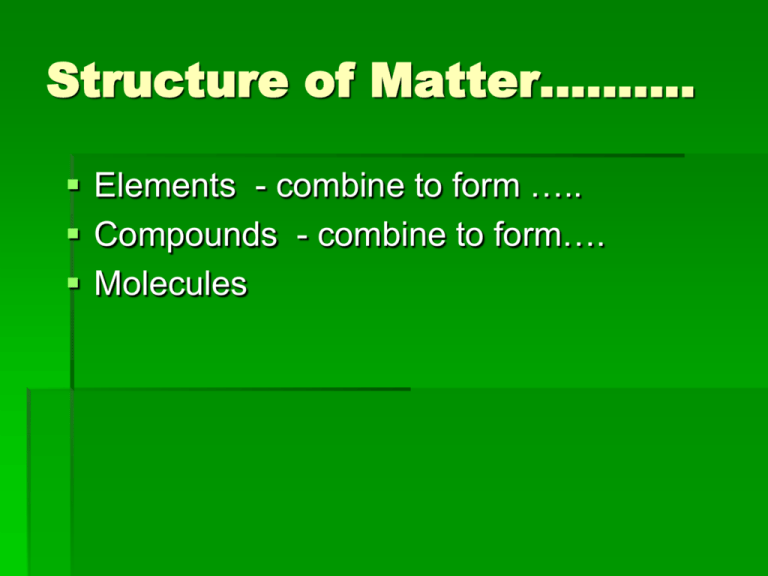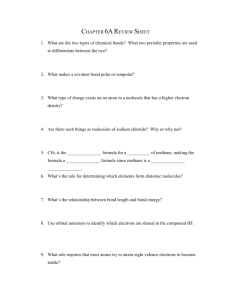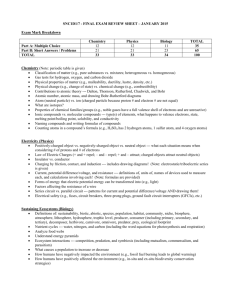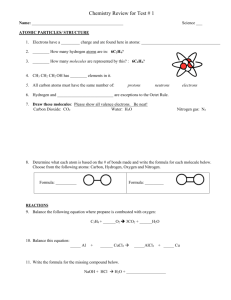The Structure of Matter
advertisement

Structure of Matter………. Elements - combine to form ….. Compounds - combine to form…. Molecules Formulas and Symbols Elements are represented by chemical symbols found on the periodic table. Examples: H, N, S, O, P, Au, Hg, Na Compounds are represented by chemical formulas Examples: H2, NO2, NH3, O2, NaCl, C6H6O6 Compounds and molecules – the attractive force that holds atoms or ions together Compound Na + Cl ---> NaCl Water is a compound…. Compounds What are compounds? - Chemical bonds distinguish compounds from mixtures A compound always has the same chemical formula Chemical structure shows the bonding within a compound Compounds Made of 2 or more elements chemically joined Pure substances Made up of molecules All molecules of a compound are identical water molecules Structure – the arrangement of bonded atoms or ions within a substance Models of Compounds Ball-and-stick model helps you “see” a compound’s structure by showing you how the atoms or ions are arranged in the compound Models of Compounds Structural Model – also shows the structures of compounds. Each connecting line represents a bond between elements. Oxygen has six valence electrons available for bonding. Each hydrogen atom has only one. Models of Compounds Space-filling models – show the space occupied by atoms (the problem with this model is that it is harder to “see” bond lengths and angles The space-filling model of water shows that the two hydrogen atoms take up much less space than the one oxygen atom. Lewis Dot Structure Shows bonds represented by lines of shared pairs of electrons and dots to represent the “leftover” valence electrons. Hydrogen Bonding Dotted lines indicate intermolecular attractions that occur between water molecules, which is often referred to as “hydrogen bonding”. Water is a liquid at room temperature because of these attractions. Bonding…. Elements “want” to bond with another element that will help it follow the octet rule when elements have either a full or empty valence energy level – full usually with 8* *except for Hydrogen & Helium Lewis Dot Structure for Molecules Bonds are represented by lines Each line represents two shared electrons Molecules follow the OCTECT rule Step by step….. 1. Count the total number of valence electrons available. 1. 2. 3. 4. For water – H2O Hydrogen in Group IA has 1 Oxygen in Group VIA has 6 H2O = 2 for hydrogen and 6 for oxygen = 8 2. Draw a “skeleton structure” for the molecule, joining atoms by single bonds. 2. A molecule H2O would be H -- O -- H Step by step….. 3. From the total number of valence electrons, subtract two for each single bond in the skeleton structure to determine how many valence electrons are left to distribute. 3. H2O has a total of 8 valence electrons. Subtract 2 for each single bond (each line) (2 x 2 = 4) : 8 - 4 = 4 remaining valence electrons Step by step….. 4. Distribute the remaining valence electrons as unshared PAIRS around the atoms in the molecule. (No single electrons) .. H -- O -- H .. Step by step….. 5. If this point is reached and there are an odd number of valence electrons to give atoms, a multiple bond is most likely necessary as well as shared pairs. 5. Example: HCN has a total of 10 valence electrons – 1 for H; 4 for C and 5 for N 6. Each line represents two – a double bond between carbon and nitrogen would still leave 1 electron for Carbon and 3 for Nitrogen – use another bond for 1 C and 1 N then draw 2 at N H-C=N: Other looks for structures You try…………….. Draw Lewis Dot Diagrams for these: 1. 2. 3. 4. 5. HBr PBr3 N2H2 C2H4 CH3OH More……… 1. BSF 2. HCl (Hydrogen and Chlorine) not Hydrogen Carbon and Iodine 3. C2H5OH 4. N2F4 5. SF6





